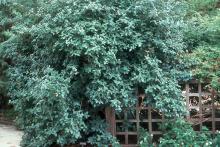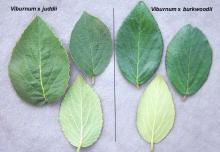Viburnum × burkwoodii
Common name:
Burkwood Viburnum
Pronunciation:
vi-BUR-num berk-WOOD-e-i
Family:
Adoxaceae, Caprifoliaceae
Genus:
Type:
Broadleaf
Native to (or naturalized in) Oregon:
No
- Semi-evergreen shrub, 8-12 ft (2.4-3 m), upright, multi-stemmed, sprawly, loose form. Leaves opposite, simple, oblong to ovate, 4-10 x 2-4.5 cm, rounded or heart-shaped, margin indistinctly sparsely toothed (dentate), upper leaf surface dark green and shinny, underside gray-brown, pubescent, veins often rusty brown. Flowers pink at first, then white, 13 mm across, in hemispherical clusters about 6 cm wide, fragrant at first; flowers in spring and much less in fall. Fruit is sparingly produced, elliptical, about 1 cm long, green, pink, red and finally black.
- Sun to part shade. Best in moist, well-drained, slightly acid soil.
- Hardy to USDA Zone (4) 5 Developed in 1924 by Burkwood & Skipworth in England (V. carlesii × V. utile)
-
Several cultivars available, including:
- ‘Mohawk’: It is a backcross of V. x burkwoodii to V. carlesii. It is primarily distinguished from V. x burkwoodii by (1) more compact size to 8 ft tall, (2) dark red flower buds are ornamental before bloom, (3) stronger and spicier flower fragrance, and (4) much better fall color (orange-red to burgundy) (Missouri Bot. Garden).
- ‘Conoy’: A hybrid from V. utile × V. ×burkwoodii 'Park Farm Hybrid', but often listed as a V. ×burkwoodii. A compact form, it is grows to 4-5 ft tall and 7-8 ft wide, is densely-branched, and the foliage is extremely glossy.
- Viburnum's in general attract birds and butterflies









